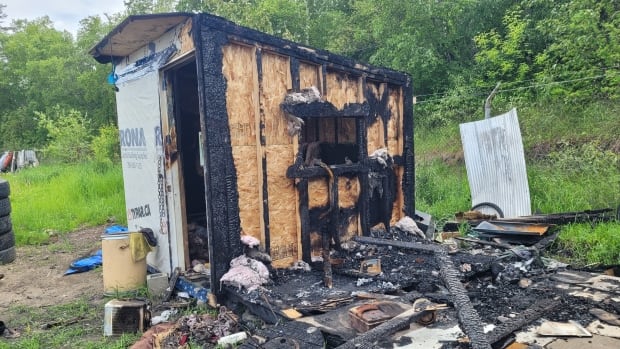A series of fires that have burned multiple tiny homes and other shelters in a homeless camp is being described as “odd” by the fire chief in Prince George, B.C.
Over the course of two weeks, from May 27 to June 10, seven shelters were destroyed in five separate fires in the Moccasin Flats homeless encampment, according to city records.
One fire was caused by an “improperly installed heating device,” during that time, said fire chief Cliff Warner.
But in the seven other cases, “the damage was such that they [the shelters] were mostly destroyed,” he said, making it “difficult to even determine where they started.”
Though there isn’t enough evidence to classify the fires as having been deliberately set, Warner noted the intensity and frequency of the fires is something he would consider “abnormal” and inconsistent with what would be expected if the causes were simply heating or cooking fires getting out of control.
“It’s almost a fire every second day, give or take,” he said.
Philip Fredriksson, a volunteer who helped build some of the shelters that have since been destroyed, was more blunt about the situation, basing his beliefs on conversations he said he’d had with people living in the camp: “These aren’t accidental,” he said.
“People are taking advantage of other people in vulnerable positions.”
The fire chief said he has received “anecdotal” information suggesting the fires were deliberately set, “but unless we can prove it unequivocally, we will never go down that path.”
However, Warner said that the scale of and damage from the fires was beyond what would be consistent with fires started by shelter residents for heating or cooking.
“The rate at which the fires spread [and] the way they’re burning is odd,” he said.
Court-protected encampment
Moccasin Flats is a court-protected homeless encampment in Prince George, approximately 500 kilometres directly north of Vancouver. The largest city in northern B.C., Prince George serves a regional population of about 90,000 people and acts as a service centre for about 300,000 across the northernmost half of the province.
Like many homeless camps across Canada, Moccasin Flats has become a source of tension within the community, with neighbours expressing concern about public safety while those working with people in the camp point out the lack of alternative housing options for many of the inhabitants.
However, the camp is also somewhat unique because it has become a court-protected, designated encampment within the city.
Shortly after the camp was first established in 2021, the city filed an application in B.C. Supreme Court to have it demolished. But that bid failed when Chief Justice Christopher E. Hinkson found there was not adequate shelter or affordable housing spaces elsewhere in the community to justify forcing people to leave the camp, a ruling that was later upheld in a second court case.
As winter sets in, a group of volunteers are building insulated shelters at a homeless camp in northern B.C., despite a warning from the city that the activity is illegal.
The city has since made efforts to address that shortcoming, partnering with the province on multiple housing projects aimed at moving people out of the camp in the hope of eventually reapplying to have it shut down. However, city council has also passed a bylaw making it illegal for people to set up camp anywhere else in the city, meaning anyone without a shelter space is, by law, required to set up in Moccasin Flats.
That move garnered criticism from people living in other camps, who said they wouldn’t feel safe being forced to live in one central location, and from residents of the nearby Millar Addition neighbourhood, who already had complaints about property crime, gunshots and fires which they attribute to people either living in or targeting people living in the camp.
Those tensions were on full display at a recent public meeting held by the city, which had more than 200 people attend, primarily to voice their complaints about the encampment.
Those complaints included worries about the impact of smoke from a series of fires in the camp that have been reported this spring.
Cause of fires officially undetermined: chief
Among the fires were two that broke out May 27, destroying two shelters. A third structure fire occurred May 29, and on May 30, a larger building known as “the bunkhouse” was also burned, with the flames spreading to two more smaller shelters, followed by yet another structure fire on June 3. A fifth structure fire burning another shelter was reported June 10.
All of these, said fire chief Warner, have been classified as “undetermined.”
“When we do an investigation, we’ll start at the unburned side of the building and work to the burned side and try to find where it started and then try to narrow it down to what caused it to start,” he explained. “When there’s a total loss in a small structure… it’s hard to even know where it started.”
Beyond that, he said, a lack of security camera footage and witnesses willing or able to provide information has made it impossible for crews to carry out an investigation the same way they might in a residential or business neighbourhood.
No open investigations: RCMP
In an emailed statement, Prince George RCMP said they do not have any open investigations into the fires. They also would not confirm whether they had received any reports or complaints indicating the fires could be deliberately set.
The lack of any open investigations worries city councillor Trudy Klassen, who said she’s concerned about the safety of both the people living in the encampment and those living nearby who are dealing with frequent smoke and poor air quality.
“If this was happening in any other neighbourhood, we would almost be in an emergency situation,” she said.
“I don’t think any area of our city, regardless of the type of housing people are living in, should have people living in fear, and I’m afraid it’s kind of devolved into that kind of situation.”
Both Klassen and Fredriksson also worry that the fires are being dismissed or ignored by the wider public, who may believe they are simply a natural consequence of allowing people to set up tents and shelters in the first place.
Fredriksson said while he’s disappointed some of the homes he helped build have been burned, he doesn’t regret his efforts to help — and says he’ll continue to try to make it safer for people without homes to shelter in Moccasin Flats until there is no more need to do so.
“Sitting around doing nothing about it doesn’t create any solutions,” he said.








